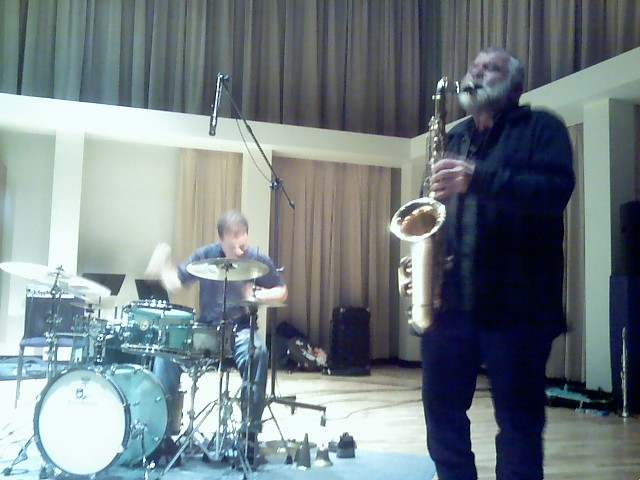
What a night of music.
It was the second evening of the Minnesota Sur Seine Festival 2006.
We were treated to two acts; first was the trio of Dominique Pifarely, from Paris, and Craig Taborn and Dave King of the Twin Cities.
This gathering yielded much in the way of knotty improvisations. Taborn’s piano stylings point to a varied approach; not just jazz, not just modern improvisation, not just classical. How refreshing to hear a pianist with wide open ears willing to take a lead or follow the group without a cliché in sight.

Pifarely’s violin, played through three pedals and a 30-watt Peavy amp, showed the same thoughtfulness. Eschewing a hard, sawing aesthetic for more refined approach, Pifarely played quick figures and phrases, matching wits with Taborn. King is a fine player, playing in unconventional ways, even incorporating a toy megaphone at one point.

Drummer Mark Sanders had a different approach – his playing in the grouping of German reed giant Peter Brötzmann and bassist Anthony Cox from the Twin Cities was marvelous. Unorthodox at times, most certainly, his playing in this context seemed to exhibit a total willingness to let the music come first. An impeccably tasteful player, Sanders. His kit accoutrements added much to the discourse. A smallish drum and cymbal next to his rack tom were used often to great effect. His collection of bells and other percussion were employed in bold manners that offered logical ideas and soul.
Bassist Anthony Cox was a man of economic expression on this evening, favoring delicious drone textures rather than busy figures. He spent the evening playing a well-mic’ed acoustic bass for a room-filling sound, especially when playing arco.
Brötzmann would lay out at times to switch between instruments or to change reeds. He changed reeds on the clarinet and tenor at least once. As when I saw him last year, part of the way through the performance he stepped to side, produced a shockingly large folding pocketknife, and proceeded to whittle the reed to his specifications. How he gets that through customs I’ll never know.
The first portion was performed with intensity right out of the gate, with Brötzmann on tarogato. After the show, he told me that he bought the instrument in a Hungarian pawn shop many years ago. It was crafted in 1830 or 1840.
Improvisations followed on clarinet and tenor. In discussing the other instruments, he had equally interesting stories – his tenor is a King brand, which he now prefers over the Selmer Mark VI he played for 30 years. It has a silver neck which Brötzmann had “reinforced” to “stabilize” it. When one plays with the ferocity of this reed-whittling man, reinforcing the instrument comes as no surprise. He purchased his clarinet for $100 in a Buffalo, NY pawn shop. His favorite technician took the tarnished item and examined it, only to discover that it was crafted out of solid silver.
After the show, I spoke with Brötzmann about his upcoming endeavors. He is working with John Corbett on a compendium of his graphic designs that will cover the 40 years after the “Inexplicable Flyswatter” book of a few years ago. We look forward to that, for sure.